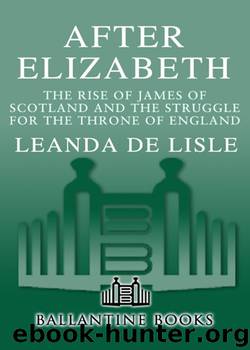After Elizabeth by Leanda de Lisle

Author:Leanda de Lisle
Language: eng
Format: epub
Tags: Nonfiction
ISBN: 9780307414472
Publisher: Random House Publishing Group
Published: 2007-12-18T05:00:00+00:00
CHAPTER FIVE
“HOPE AND FEAR” Winners and Losers, April–May 1603
The head of the Jesuit order in England, Henry Garnet, had shown several soldiers the papal edict calling on Catholics to defy the accession of a Protestant—among them the future gunpowder plotter Robert Catesby. But since resistance to the proclamation declaring James king had proved negligible a new response was called for. Within days of Elizabeth’s death, the stocky, flaxen-haired priest had written to “a Catholic nobleman,” probably the Earl of Worcester, asking him to tell James that the Jesuits offered him “all the love, fidelity, duty and obedience which can be desired or yielded by any Christian heart.”1 It was a strategic response: they had no choice but to accept James’s fait accompli, and in secret they would continue to seek means and opportunities to advance their cause of restoring the Catholic faith.
While the Jesuits had never supported James’s accession, and nothing he was likely to do was therefore going to disappoint them, many of the Catholic secular clergy had backed James’s candidature and they now realized their mistake. The royal pardons that had left Catholics in prison alongside murderers had put paid to the lie that James had ever intended to offer religious toleration. Catholics such as the Howards might be allowed to play a leading role in government, but they would not be allowed the free exercise of their faith; the price of their power was to risk their souls. As James left York the Venetian ambassador Scaramelli reported that James’s Scots agents had confirmed that the most Catholics could hope for was the remission of recusancy fines—and he warned that even that was in doubt.2
In the winter James had told Cecil that he expected the seculars to be expelled from England along with the Jesuits. He was not interested in “the distinction in their ranks”; both were subject to the authority of the Pope and he wanted both “safely transported beyond the seas, where they may freely glut themselves on their imagined gods.” 3 Cecil was now trying to work out how this could be best achieved. It was important that people not feel inclined to pity the Catholic clergy or resent their treatment. The most effective way to achieve that was for them to be tarnished by treason. In the past plots had been “wakened” by corralling malcontents into actions against the state and there was an outstanding candidate to play such a part now: the most vocal of James’s supporters within the seculars had been a short, cross-eyed priest called William Watson, whose personal history is illustrative of the extraordinary bitterness between the Jesuits and those who sought to compromise with the state.
The story of the Elizabethan Catholic priesthood was not straightforwardly one of Catholic priests versus a savage absolutist state: sometimes it was one of Catholic priest against Catholic priest. Watson, now in his thirties, had left England at the age of sixteen to train as a priest at Douai, a Catholic college founded by William (later Cardinal) Allen, which was then at Rheims.
Download
This site does not store any files on its server. We only index and link to content provided by other sites. Please contact the content providers to delete copyright contents if any and email us, we'll remove relevant links or contents immediately.
Fanny Burney by Claire Harman(26492)
Empire of the Sikhs by Patwant Singh(22912)
Out of India by Michael Foss(16758)
Leonardo da Vinci by Walter Isaacson(13114)
Small Great Things by Jodi Picoult(6878)
The Six Wives Of Henry VIII (WOMEN IN HISTORY) by Fraser Antonia(5365)
The Wind in My Hair by Masih Alinejad(5014)
A Higher Loyalty: Truth, Lies, and Leadership by James Comey(4803)
The Lonely City by Olivia Laing(4715)
The Crown by Robert Lacey(4695)
Millionaire: The Philanderer, Gambler, and Duelist Who Invented Modern Finance by Janet Gleeson(4309)
The Iron Duke by The Iron Duke(4258)
Papillon (English) by Henri Charrière(4155)
Sticky Fingers by Joe Hagan(4071)
Joan of Arc by Mary Gordon(3987)
Alive: The Story of the Andes Survivors by Piers Paul Read(3931)
Stalin by Stephen Kotkin(3831)
Aleister Crowley: The Biography by Tobias Churton(3540)
Ants Among Elephants by Sujatha Gidla(3369)
